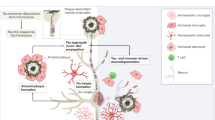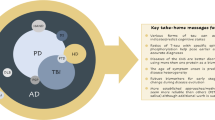Abstract
Alzheimer′s disease is a progressive and incurable disease whose prevalence increases dramatically with age. A biochemical marker for monitoring the onset and progression of the disease would be a valuable tool for disease management. In addition, such a marker might be used as an end point in clinical intervention protocols. Here we provide evidence that the soluble form of the iron binding protein p97 is found in elevated amounts in the serum of Alzheimer′s patients compared with healthy controls. This biochemical marker has the potential for identifying subjects afflicted with the disease and possibly for monitoring the onset and longitudinal progression of the disease.
This is a preview of subscription content, access via your institution
Access options
Subscribe to this journal
Receive 12 print issues and online access
$209.00 per year
only $17.42 per issue
Buy this article
- Purchase on Springer Link
- Instant access to full article PDF
Prices may be subject to local taxes which are calculated during checkout
Similar content being viewed by others
References
Goedert, M., Spillantini, M.G., Cairns, N.J. & Crowther, R.A. Tau protein of Alzheimer paired helical filaments: Abnormal phosphorylation of all six brain isoforms. Neuron 8, 156–160 (1992).
Selkoe, D.J. The molecular pathology of Alzheimer's disease. Neuron 6, 487–498 (1991).
Terry, R.D., Masliah, E. & Salmon, D.P. Physical basis of cognitive alterations in Alzheimer's disease: Synapse loss is the major correlate of cognitive impairment. Ann. Neural. 30, 572–580 (1991).
Blass, J.P. Pathophysiology of Alzheimer's syndrome. Neurology 43, S25–38 (1993).
McKhann, G. et al. Clinical diagnosis of Alzheimer's disease — Report of the NINCDS-ADRDA Work Group under the auspices of Department of Health and Human Services Task Force on Alzheimer's disease. Neurology 34, 939–944 (1984).
Shoji, M. et al. Production of the Alzheimer amyloid beta protein by normal proteolytic cleavage. Science 258, 126–129 (1992).
Nakamura, T. et al. Amyloid b protein levels in cerebrospinal fluid are elevated in early-onset Alzheimer's disease. Ann. Neurol 36, 903–911 (1994).
Roher, A.E. et al. Structural alterations in the peptide backbone of β-amyloid core protein may account for its deposition and stability in Alzheimer's disease. J. Biol. Chem. 268, 3072–3083 (1993).
Motter, R. et al. Reduction of β-amyloid peptide42, in the cerebrospinal fluid of patients with Alzheimer's disease. Ann. Neurol. 38, 643–648 (1995).
Van Nostrand, W.E. et al. Decreased levels of soluble amyloid beta-protein precursor in cerebrospinal fluid of live Alzheimer patients. Proc. Natl. Acad. Sci. USA 89, 2551–2555 (1992).
Palmert, M.R. et al. Soluble derivatives of the beta amyloid protein precursor in cerebrospinal fluid. Neurol. 40, 1028–1034 (1990).
Kitaguchi, N. et al. Determination of amyloid beta protein precursors harboring active form of protease inhibitor domains in cerebrospinal fluid in Alzheimer′s disease patients by a trypsin antibody sandwich ELISA. Biochem. Biophys. Res. Commun. 166, 1453–1459 (1990).
Vigo-Pelfrey, C. et al. Elevation of microtubule-associated protein tau in the cerebrospinal fluid of patients with Alzheimer′s disease. Neurology 45, 788–793 (1995).
Vandermeeren, M. et al. Detection of tau proteins in normal and Alzheimer′s disease cerebrospinal fluid with a sensitive sandwich enzyme-linked immunosorbent assay. J. Neurochem. 61, 1828–1834 (1993).
Abraham, C.R., Selkoe, D.J. & Potter, H. Immunochemical identification of the serine protease inhibitor alpha 1-antichymotrypsin in the brain amyloid deposits of Alzheimer′s disease. Cell 52, 487–501 (1988).
Wang, G.P. et al. Alzheimer′s disease: Paired helical filament immunoreactivity in cerebrospinal fluid. Acta Neuropathol.(Berl.) 82, 6–12 (1991).
Sanders, A.M. et al. Association of apolipoprotein E allele 4 with late-onset familial and sporadic Alzheimer's disease. Neurology 43, 1467–1472 (1993).
Murrell, J., Farlow, M., Ghetti, B. & Benson, M.D. A mutation in the amyloid precursor protein associated with hereditary Alzheimer′s disease. Science 254, 97–99 (1991).
Karlinsky, H. et al. Molecular and prospective phenotypic characterization of a pedigree with familial Alzheimer's disease and a missense mutation of codon of the beta amyloid precursor protein gene. Neurology 42, 1445–1453 (1992).
Schellenberg, G.D. et al. Genetic linkage evidence for a familial Alzheimer's disease locus on chromosome 14. Science 258, 668–671 (1992).
Sherrington, R. et al. Cloning of a gene bearing missense mutations in the early onset of familial Alzheimer′s disease. Nature 375, 754–760 (1995).
Levy-Lahad, E. et al. Candidate genes for the chromosome 1 familial Alzheimer′s disease locus. Science 269, 973–977 (1995).
Rogaev, E.I. et al. Familial Alzheimer′s disease in kindreds with missense mutations in a gene on chromosome 1 related to Alzheimer′s disease type 3 gene. Nature 376, 775–778 (1995).
Strittmatter, W.J. et al. Apolipoprotein E: High avidity binding to beta-amyloid and increased frequency of type 4 allele in late-onset familial Alzheimer's disease. Proc. Natl. Acad. Sci. USA 90, 1977–1981 (1993).
Brown, J.P., Nishiyama, K., Hellström, I. & Hellström, K.E. Structural characterization of human-melanoma-associated antigen p97 with monoclonal antibodies. J. Immunol. 127, 539–546 (1981).
Baker, E.N., Rumball, S.V. & Anderson, B.F. Insights into structure and function from studies on lactoferrin. Trends Blochetn. Sci. 12, 350–353 (1987).
Kennard, M.L., Richardson, D.R., Gabathuler, R., Ponka, P. & Jefferies, W.A. A novel iron uptake mechanism mediated by GPI-anchored human p97. EMBO J. 14, 4178–4186 (1995).
Food, M.R. et al. Transport and expression in human melanomas of a transferrinlike glycosylphospatidylinositol-anchored protein. J. Biol. Chem. 269, 3034–3040 (1994).
Rothenberger, S. et al. Coincident expression and distribution of melanotransferrin and transferrin receptor in human brain capillary endothelium. Brain Res. 712, 117–121 (1996).
Jefferies, W.A. et al. Reactive microglia specifically associated with amyloid plaques in Alzheimer's disease express melanotransferrin. Brain Res. 712, 122–126 (1996).
Kennard, M.L., Food, M.R., Jefferies, W.A. & Piret, J.M. Controlled process to recover heterologous glycosylphosphatidylinositol membrane anchored proteins from CHO cells. Biotech. Bioeng. 42, 480–486 (1993).
Brown, J.P., Woodbury, E.G., Hart, C.E., Hellström, I. & Hellströ, K.E. Quantitative analysis of melanoma-associated antigen p97 in normal neoplastic tissues. Proc. Natl. Acad. Sci. USA 78, 539–543 (1981).
Connor, J.R., Menzies, S.L., St Martin, S.M. & Mufson, E.J. A histochemical study of iron, transfcrrin and ferritin in Alzheimer′s disease brains. J. Neurosci. Res. 31, 75–83 (1992).
Gerlach, M., Ben-Shachar, D., Riederer, P. & Youdim, M.B.H. Altered brain metabolism of iron as a cause of neurodegenerative diseases. J. Neurochem. 63, 793–807 (1994).
Multhaup, G. et al. The amyloid precursor protein of Alzheimer's disease in the reduction of copper (II) to copper (I). Science 271, 1406–1409 (1996).
Dedman, D.J. et al. Iron and aluminium in relation to brain ferritin in normal individuals and Alzheimer′s disease and chronic real-dialysis patients. Biochem. J. 287, 509–514 (1992).
Mantyh, P.W. et al. Aluminum, iron and zinc ions promote aggregation of physiological concentrations of beta-amyloid peptide. J. Neurochem. 61, 1171–1174 (1993).
Bush, A.I. et al. Zinc and Alzheimer′s disease. Science 268, 1921–1922 (1995).
Ehmann, W.D. et al. Brain trace elements in Alzheimer′s disease. Neumtoxicology 7, 195–206 (1986).
Robinson, S.R., Noone, D.F., Kril, J. & Halliday, G.M. Most amyloid plaques contain ferritin rich cells. Alzheimer′s Res. 1, 191–196 (1996).
Grundke-Iqbal, I. et al. Ferritin is a component of the neuritic (senile) plaque in Alzheimer dementia. Acta Neumpathalogica. 81, 105–110 (1990).
Good, P.F., Perl, D.P., Bierer, L.M. & Schmeidler, J. Selective accumulation of aluminum and iron in the neurofibrillary tangles of Alzheimer′s disease. Ann. Neural 31, 286–292 (1992).
McLachlan, D.R.C. et al. Intramuscular desferroxamine in patients with Alzheimer′s disease. Lancet 337, 1304–1308 (1991).
Bodovitz, S., Faltudo, M.T., Frail, F.E. & Klein, W.L. Iron levels modulate alpha-sec-retase cleavage of amyloid precursor protein. J. Neuruchem. 64, 307–315 (1995).
Zubcnko, G.S. et al. Clinically silent mutation in the putative iron-response element in exon 17 of the beta-amyloid precursor protein gene. J. Neuroputhol. Exp. Neurol. 51, 459–463 (1992).
Jolley, M. et al. Particle concentration fluorescence immunoassay (PCFIA): A new rapid immunoassay technique with high sensitivity. J. Imnunnol. Methods 67, 21–35 (1984).
Author information
Authors and Affiliations
Rights and permissions
About this article
Cite this article
Kennard, M., Feldman, H., Yamada, T. et al. Serum levels of the iron binding protein p97 are elevated in Alzheimer′s disease. Nat Med 2, 1230–1235 (1996). https://doi.org/10.1038/nm1196-1230
Received:
Accepted:
Issue Date:
DOI: https://doi.org/10.1038/nm1196-1230
This article is cited by
-
Complex of human Melanotransferrin and SC57.32 Fab fragment reveals novel interdomain arrangement with ferric N-lobe and open C-lobe
Scientific Reports (2021)
-
Anti-cancer Antibody Trastuzumab-Melanotransferrin Conjugate (BT2111) for the Treatment of Metastatic HER2+ Breast Cancer Tumors in the Brain: an In-Vivo Study
Pharmaceutical Research (2016)
-
The melanoma tumor antigen, melanotransferrin (p97): a 25-year hallmark – from iron metabolism to tumorigenesis
Oncogene (2007)
-
Biomarkers of neurodegeneration for diagnosis and monitoring therapeutics
Nature Reviews Drug Discovery (2007)
-
Blood—Brain Barrier Permeability Precedes Senile Plaque Formation in an Alzheimer Disease Model
Microcirculation (2003)



